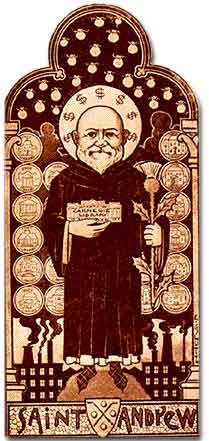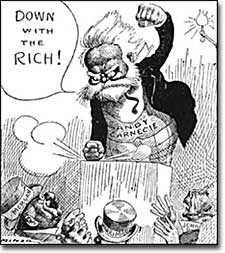People Who Wrote Agains Andrew Carnegie

36c. The New Tycoons: Andrew Carnegie

By the time he died in 1919, Carnegie had given away $350,695,653. At his death, the last $30,000,000 was likewise given away to foundations, charities and to pensioners.
Oil was not the only commodity in great demand during the Gilded Age. The nation also needed steel.
The railroads needed steel for their rails and cars, the navy needed steel for its new naval fleet, and cities needed steel to build skyscrapers. Every factory in America needed steel for their physical plant and machinery. Andrew Carnegie saw this demand and seized the moment.
Humble Roots
Like John Rockefeller, Andrew Carnegie was not born into wealth. When he was 13, his family came to the United States from Scotland and settled in Allegheny, Pennsylvania, a small town near Pittsburgh. His first job was in a cotton mill, where he earned $1.20 per week.
His talents were soon recognized and Carnegie found himself promoted to the bookkeeping side of the business. An avid reader, Carnegie spent his Saturdays in the homes of wealthy citizens who were gracious enough to allow him access to their private libraries. After becoming a telegrapher for a short while, he met the head of a railroad company who asked his services as a personal secretary.

Millionaire Andrew Carnegie spoke against irresponsibility of the wealthy and sharply criticized ostentatious living.
During the Civil War, this man, Thomas Scott, was sent to Washington to operate transportation for the Union Army. Carnegie spent his war days helping the soldiers get where they needed to be and by helping the wounded get to hospitals. By this time, he had amassed a small sum of money, which he quickly invested. Soon iron and steel caught his attention, and he was on his way to creating the largest steel company in the world.
Vertical Integration: Moving on Up
The Bessemer Process
When William Kelly and Henry Bessemer perfected a process to convert iron to steel cheaply and efficiently, the industry was soon to blossom.
Carnegie became a tycoon because of shrewd business tactics. Rockefeller often bought other oil companies to eliminate competition. This is a process known as horizontal integration. Carnegie also created a vertical combination, an idea first implemented by Gustavus Swift. He bought railroad companies and iron mines. If he owned the rails and the mines, he could reduce his costs and produce cheaper steel.
Carnegie was a good judge of talent. His assistant, Henry Clay Frick, helped manage the Carnegie Steel Company on its way to success. Carnegie also wanted productive workers. He wanted them to feel that they had a vested interest in company prosperity so he initiated a profit-sharing plan.
All these tactics made the Carnegie Steel Company a multi-million dollar corporation. In 1901, he sold his interests to J.P. Morgan, who paid him 500 million dollars to create U.S. Steel.
Giving Back
Retirement did not take him out of the public sphere. Before his death he donated more than $350 million dollars to public foundations. Remembering the difficulty of finding suitable books as a youth, he helped build three thousand libraries. He built schools such as Carnegie-Mellon University and gave his money for artistic pursuits such as Carnegie Hall in New York.
Andrew Carnegie was also dedicated to peace initiatives throughout the world because of his passionate hatred for war. Like Rockefeller, critics labeled him a robber baron who could have used his vast fortunes to increase the wages of his employees. Carnegie believed that such spending was wasteful and temporary, but foundations would last forever. Regardless, he helped build an empire that led the United States to world power status.
Source: https://www.ushistory.org/us/36c.asp
0 Response to "People Who Wrote Agains Andrew Carnegie"
Post a Comment